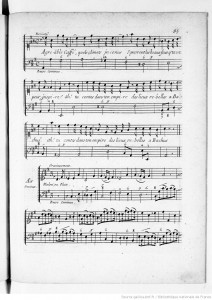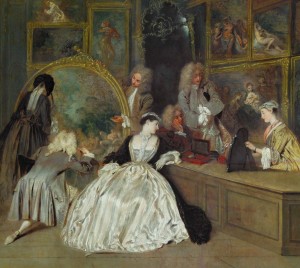by Anne Schuster Hunter

Nicolas Bernier, Le Caffé, original sheet music from Cantates Françoises, volume 3, Édition Foucault, 1703, Bibliothèque Nationale de France, Département Musique, VM7-216.
Ah, French style. Coffee in a porcelain demitasse. Champagne in a glass flute. Eat-your-heart-out chic, the perfect little bag, and shoes to die for. The scarf tied just so. The pout, the coy glance, the moue…oh, just the whole French thing. Sure, we’re democratic here in America. But we love the classy.
In Café & Catastrophe: Chamber Cantatas by Bernier & Bourgeois, Tempesta di Mare and soprano Rosa Lamoreaux bring us supremely elegant music from the turn of the eighteenth-century, the moment when the French almost literally invented classiness. Consider it a Parisian holiday for your ears.
Nicholas Bernier’s Le Caffé, Thomas-Louis Bourgeois’s Phèdre et Hyppolite and François Couperin’s songs are the kind of exquisite, refined entertainment associated with the nobility in Paris around 1700. Louis XIV was aging by then and liberating his nobles from constant attendance at Versailles, twelve miles out of the city. Gradually, the upper crust was moving back into the city and establishing its own high society culture.
Paris (and suburban chateaux) became the site of legendary parties, salons and gatherings of all sorts. It also saw the rise of celebrity couturiers, celebrity coiffeurs, fine French cuisine and beautiful places to eat it in. And the scene wasn’t just for bluebloods. Wealthy commoners and out-of-towners were shopping, eating, romancing, entertaining and by walking the banks of the Seine. And shopping. Oh yes, shopping.

Jean-Antoine Watteau, The Shop Sign of Gersaint, (1720-21), sign painted for the art dealer Edme-François Gersaint showing customers at his Parisian shop looking at paintings and, probably, jewelry. Collection Charlottenburg Palace, Berlin. (Detail of right panel shown)
Coffee in a porcelain demitasse. Champagne in a glass flute. Eat-your-heart-out chic, the perfect little bag, and shoes to die for. The scarf tied just so.
Swanky little shops sprouted up in the fashionable districts offering dresses and waistcoats, paintings, prints, antiquities, curiosities and serious jewels as well as everything pretty from fancy combs to deluxe, hand-painted stockings.
French music was there to tickle your budget, too. Shops like M. Foucault’s on the rue Saint-Honoré carried sheet music, so if you loved Le Caffé at the shindig last night, you could nip around to the store and pick a copy up for the folks back home. And if you were German or English and didn’t have that swing, you could also buy a handbook that explained how to play the decorations—the agréments—“correctly and with taste,” as Jacques-Martin Hotteterre wrote in 1707.
Which is how you’ll hear it when Tempesta di Mare and Rosa Lamoreaux bring Café & Catastrophe and the sparkle of 1700’s Paris to 21st-century Philadelphia. So pretend you haven’t just paid your taxes, sit back and think embroidered high heels, swishing silk and glinting diamonds as Tempesta transports you to Cinderella’s ball (written by Parisian Charles Perrault in 1697, just by the way). Your pumpkin awaits.
